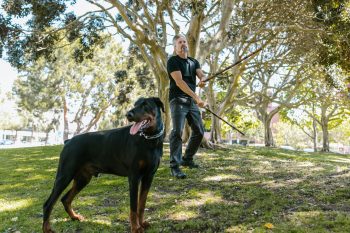Dogs have been known as loyal protectors and companions for thousands of years, serving not just as pets but as members of the family who play an integral role in the safety and security of their household. Their instincts to protect are deeply ingrained, stemming from their ancestral pack behavior, where looking out for one another was essential for survival. Today, these protective instincts manifest in various ways tailored to the domesticated environment they now inhabit. Recognizing the signs that your dog is trying to protect you is crucial for understanding their behavior and ensuring their efforts are guided positively and safely. It enhances the bond between dog and owner, fostering mutual respect and understanding. This article will delve into seven critical signs that your dog is trying to protect you, explaining the motivations behind each behavior and how they fit into the broader context of canine loyalty and protection.
1. Body Blocking
Body blocking is a protective behavior where a dog positions itself between its owner and a perceived threat. This can be a subtle move, such as standing in front of you when someone approaches, or more pronounced, like pushing you away from an unfamiliar situation. This behavior indicates that your dog is actively safeguarding you from what it perceives as danger. It’s their way of saying they’re on guard and ready to shield you from harm. Understanding this behavior as a protective act allows owners to appreciate their dog’s instincts and work on training methods that manage their protective responses appropriately.
2. Barking at Perceived Threats
Barking is one of the most common signs a dog uses to alert its owner to potential threats. When your dog barks at strangers, noises, or other animals, it’s often an attempt to ward off potential threats and protect you. This vocalization serves as both a deterrent to the perceived threat and a signal that something unusual is happening. While barking can sometimes be excessive, recognizing it as a form of protection helps train your dog to distinguish between typical and threatening situations, ensuring they react appropriately.
3. Growling in Warning
Growling is a more direct form of communication, signaling discomfort, fear, or the presence of a perceived threat. When a dog growls in certain situations, it’s not just expressing its unease; it’s also trying to protect you by warning off whatever it perceives as dangerous. Growling should not be punished, as it’s a crucial way dogs communicate their boundaries and warn before potentially escalating to more aggressive behaviors. Understanding and respecting this warning allows owners to safely remove themselves and their dogs from potentially threatening situations.
4. Vigilant Watching
A dog trying to protect you will often exhibit vigilant behavior, constantly watching and sometimes staring intently at potential threats. This watchfulness means they’re assessing the environment for signs of danger to keep you safe. Dogs with protective solid instincts take this role very seriously and can often be seen scanning their surroundings, especially in new or unfamiliar places. Recognizing this behavior as a protective measure allows owners to reassure their dogs and healthily manage their alertness.
5. Physical Positioning
Protective dogs will often position themselves in a way that allows them to act quickly if needed. This can include lying or sitting in strategic locations, such as doorways or by their owner’s side, especially in public places. This positioning is not just about comfort; it’s a calculated choice to protect. By understanding this, owners can appreciate their dog’s protective instincts and work with them to ensure they feel secure in their role.
6. Following You Closely
When a dog follows you closely, particularly in unfamiliar environments, it’s often a sign they’re trying to protect you. This behavior, known as “shadowing,” ensures they’re always close enough to intervene if a threat arises. It demonstrates their commitment to your safety and readiness to act as your guardian. Recognizing this behavior as protective rather than needy allows a more empathetic approach to managing their protective instincts.
7. Alerting You to Unusual Activity
Dogs have keen senses and often alert their owners to unusual activity or noises the human ear might not detect. This alerting behavior, whether through barking, becoming visibly alert, or nudging their owner, is a way of protecting by ensuring you’re aware of potential dangers. Appreciating this aspect of your dog’s behavior can help strengthen the bond between you, as it highlights their role as a vigilant protector.
A dog’s signs when trying to protect its owner are varied but deeply rooted in their instincts as pack animals. Recognizing and understanding these signs—body blocking, barking, growling, vigilant watching, physical positioning, following closely, and alerting to unusual activity—can significantly enhance the relationship between a dog and its owner. It allows for a deeper appreciation of the dog’s protective instincts and provides opportunities to guide these behaviors positively. Through mutual respect and understanding, owners can ensure their protective dogs feel valued and secure in their roles, fostering a safe and loving environment for all.
The post 7 Signs Your Dog Is Really Trying To Protect You appeared first on iHeartDogs.com.

